| Books & Catalogues |
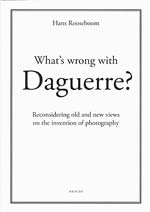
Hans Rooseboom
What's Wrong with Daguerre: Reconsidering old and new views on the invention of photography
2010
Book/Pamphlet softbound
8-1/4 x 5-7/8 in. (210 x 149 mm)
[Published Nescio, 2010 Amsterdam] Limited edition of only 500 copies. From Hans Rooseboom, curator of photography at the Rijksmuseum in Amsterdam, comes a finely researched, self-published monograph, "What's Wrong with Daguerre?" This 35-page treatise explores the historical record, familiarly noting that when Louis-Jacques-Mandé Daguerre introduced his daguerreotype process in 1839, he was regarded as photography's principal inventor, but that it wasn't long before other innovators--notably Joseph- Nicéphore Niépce, William Henry Fox Talbot and Hippolyte Bayard--were viewed as rivals, sparking the "priority debate" about who was the rightful father of photography.With ample citations and clear comparative analysis, Rooseboom argues compellingly that Daguerre's problem (that is, the devaluation of his role and his process) has often been a matter of bias or nationalism on the part of photo-historians and others who, for example, view the daguerreotype as an instrument of commercialism and the calotype of Fox Talbot as a purer expression of photographic art.
Price: $15 (ref. 12453)
What's Wrong with Daguerre: Reconsidering old and new views on the invention of photography
2010
Book/Pamphlet softbound
8-1/4 x 5-7/8 in. (210 x 149 mm)
[Published Nescio, 2010 Amsterdam] Limited edition of only 500 copies. From Hans Rooseboom, curator of photography at the Rijksmuseum in Amsterdam, comes a finely researched, self-published monograph, "What's Wrong with Daguerre?" This 35-page treatise explores the historical record, familiarly noting that when Louis-Jacques-Mandé Daguerre introduced his daguerreotype process in 1839, he was regarded as photography's principal inventor, but that it wasn't long before other innovators--notably Joseph- Nicéphore Niépce, William Henry Fox Talbot and Hippolyte Bayard--were viewed as rivals, sparking the "priority debate" about who was the rightful father of photography.With ample citations and clear comparative analysis, Rooseboom argues compellingly that Daguerre's problem (that is, the devaluation of his role and his process) has often been a matter of bias or nationalism on the part of photo-historians and others who, for example, view the daguerreotype as an instrument of commercialism and the calotype of Fox Talbot as a purer expression of photographic art.
Price: $15 (ref. 12453)

August Sander
August Sander: Rheinlandschaften 1929-1946
1975
Book hardbound
0 x 0 in. (0 x 0 mm)
Photographs by August Sander and text by Wolfgang Kemp. Schirmer/Mosel, Munich, 1975. Quarto. Hardcover in very fine condition with very fine dust jacket. First edition, 58pp., text-illustrations, plus 40 full-page b&w photos. In German. Kemp recounts early landscape photography and art, and Sander's landscapes, portraits and biography. Excellent condition in a scarce book.
Price: $350 (ref. 9026)
August Sander: Rheinlandschaften 1929-1946
1975
Book hardbound
0 x 0 in. (0 x 0 mm)
Photographs by August Sander and text by Wolfgang Kemp. Schirmer/Mosel, Munich, 1975. Quarto. Hardcover in very fine condition with very fine dust jacket. First edition, 58pp., text-illustrations, plus 40 full-page b&w photos. In German. Kemp recounts early landscape photography and art, and Sander's landscapes, portraits and biography. Excellent condition in a scarce book.
Price: $350 (ref. 9026)
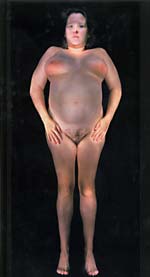
Gary Schneider
Gary Schneider: Nudes
2005
Book hardbound
18-1/4 x 9-1/4 in. (464 x 235 mm)
Aperture Foundation, New York City, NY, 2005. Hardcover. First Edition. First Printing. 80pp., 35 four-color illustrations. As New in partial shrink wrap. Debut collection of male and female full-frontal nudes. One of the most unusual and most fascinating erotic and portrait photography books of the year 2005. Published in a small and limited print run as a hardcover original only. A stunningly beautiful production by Gary Schneider, Francesca Richer, and Aperture Foundation: Oversize-volume format. The book is 18-1/4 inches long. Handsome black silk cloth boards with glossy photographic reproduction of a female nude pasted on cover and metallic-silver titles printed on spine, as issued. Photographs and brief afterword by Gary Schneider. Printed on 200 gsm Garda thick coated stock paper by EBS in Verona, Italy to the very highest standards. Without DJ, as issued. Presents the American artist/photographer"s very first, full-fledged collection of nudes. Gary Schneider began experimenting with his unusual lighting technique in 1989, but he did not take these photographs until 2002 through 2004. The book is dedicated to Peter Hujar, who was his best friend, and John Erdman, his lifelong partner. Like all great photographic nudes, Gary Schneider's nudes delicately tread the line between the nude-as-study and the nude-as-erotic-object. They are not mutually exclusive. On the contrary, they are mutually inclusive. Schneider used a small flash light to photograph each subject. What we see is not digitally altered in any way; the pitch-dark surrounding is real; and most crucial of all, the dark areas of the bodies that make many of the subjects look unusually hairy (or "rubbed over with charcoal", as one critic observed) are intentional on Schneider's part. The results are unlike anything anyone has seen or expects, and are therefore disorienting and even unsettling. You can't help looking, looking away, and looking back again, this time to linger, appreciate, and enjoy. Very few nudes afford us such an experience and reward repeated viewings so richly. Schneider is, in effect, applying and extending what he learned from a lifetime of portraiture to leave his indelible mark on the nude. His nudes can only be described as original and moving portraits of the human body in all of its particularity and beauty. "Schneider illuminates contemporary art and science, conceptual art and performance, portraiture and identity, and privacy within the public sphere", according to Deborah Martin Kao. Schneider's achievement was finally recognized in a major retrospective exhibition simply called "Portraits" at The Harvard University Art Museum in 2004. His new collection presents the nude-as-portrait.
Price: $75 (ref. 9171)
Gary Schneider: Nudes
2005
Book hardbound
18-1/4 x 9-1/4 in. (464 x 235 mm)
Aperture Foundation, New York City, NY, 2005. Hardcover. First Edition. First Printing. 80pp., 35 four-color illustrations. As New in partial shrink wrap. Debut collection of male and female full-frontal nudes. One of the most unusual and most fascinating erotic and portrait photography books of the year 2005. Published in a small and limited print run as a hardcover original only. A stunningly beautiful production by Gary Schneider, Francesca Richer, and Aperture Foundation: Oversize-volume format. The book is 18-1/4 inches long. Handsome black silk cloth boards with glossy photographic reproduction of a female nude pasted on cover and metallic-silver titles printed on spine, as issued. Photographs and brief afterword by Gary Schneider. Printed on 200 gsm Garda thick coated stock paper by EBS in Verona, Italy to the very highest standards. Without DJ, as issued. Presents the American artist/photographer"s very first, full-fledged collection of nudes. Gary Schneider began experimenting with his unusual lighting technique in 1989, but he did not take these photographs until 2002 through 2004. The book is dedicated to Peter Hujar, who was his best friend, and John Erdman, his lifelong partner. Like all great photographic nudes, Gary Schneider's nudes delicately tread the line between the nude-as-study and the nude-as-erotic-object. They are not mutually exclusive. On the contrary, they are mutually inclusive. Schneider used a small flash light to photograph each subject. What we see is not digitally altered in any way; the pitch-dark surrounding is real; and most crucial of all, the dark areas of the bodies that make many of the subjects look unusually hairy (or "rubbed over with charcoal", as one critic observed) are intentional on Schneider's part. The results are unlike anything anyone has seen or expects, and are therefore disorienting and even unsettling. You can't help looking, looking away, and looking back again, this time to linger, appreciate, and enjoy. Very few nudes afford us such an experience and reward repeated viewings so richly. Schneider is, in effect, applying and extending what he learned from a lifetime of portraiture to leave his indelible mark on the nude. His nudes can only be described as original and moving portraits of the human body in all of its particularity and beauty. "Schneider illuminates contemporary art and science, conceptual art and performance, portraiture and identity, and privacy within the public sphere", according to Deborah Martin Kao. Schneider's achievement was finally recognized in a major retrospective exhibition simply called "Portraits" at The Harvard University Art Museum in 2004. His new collection presents the nude-as-portrait.
Price: $75 (ref. 9171)
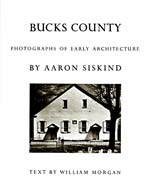
Aaron Siskind
Bucks County: Photographs of Early Architecture
1974
Book hardbound
0 x 0 in. (0 x 0 mm)
Horizon Press, NY, 1974. Hardcover quarto. First edition. 112 pages. Handsome brown cloth boards with titles on spine, as issued. Photographs by Aaron Siskind. Essay by William Morgan. In pictorial dust jacket with titles on the cover and spine, as issued. Presents an unusual document in Aaron Siskind's seminal oeuvre. It is instructive of Siskind's growth and development as one of the most influential American photographers. Drawn to both the rural and artistic reputation of Bucks County, Siskind arrived in 1935 to photograph its architecture. Very fine.
Price: $125 (ref. 9022)
Bucks County: Photographs of Early Architecture
1974
Book hardbound
0 x 0 in. (0 x 0 mm)
Horizon Press, NY, 1974. Hardcover quarto. First edition. 112 pages. Handsome brown cloth boards with titles on spine, as issued. Photographs by Aaron Siskind. Essay by William Morgan. In pictorial dust jacket with titles on the cover and spine, as issued. Presents an unusual document in Aaron Siskind's seminal oeuvre. It is instructive of Siskind's growth and development as one of the most influential American photographers. Drawn to both the rural and artistic reputation of Bucks County, Siskind arrived in 1935 to photograph its architecture. Very fine.
Price: $125 (ref. 9022)
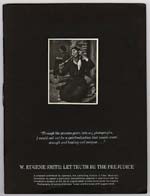
W. Eugene Smith
Let Truth Be The Prejudice exhibition and book proposal
1980c
Book softbound
12 x 9 in. (305 x 229 mm)
A hand sewn brochure maquette of a proposal submitted by Aperture for the publication and exhibition of Let Truth Be The Prejudice containing 12 iconic photographs by photojournalist W. Eugene Smith (1918 - 1978) including: Soldiers, Siapan, 1944; Sticks and Bones, Iwo Jima, 1945; The Spinner, 1951 (from Spanish Village essay); Nurse Midwife Maude Callen,1951; Dr. Albert Schweitzer, 1955 (from Man of Mercy); Welch Miners, 1950; Guardia Civil, 1951; and Country Doctor, 1948. In add to the photographs there is a 12 page typed proposal and budget for the book and exhibition.Photographs are early posthumous silver prints ranging in size form 4 x 3 inches to 11-3/4 x 9-1/4 inches.A Book was published in 1985 (Aperture) and exhibition organized by the Alfred Stieglitz Center of the Philadelphia Museum of Art in association with the Center for Creative Photography, University of Arizona, opened in Philadelphia (October 19, 1985 - January 5 1986) and was held at International Center of Photography (March 28 - May 4, 1986) then the Museum of Contemporary Art, Los Angeles; Carnegie Museum of Art, Pittsburgh; Amon Carter Museum, Fort Worth, Texas; High Museum of Art, Atlanta; Minneapolis Institute of Arts; Cleveland Museum of Art; Glenbow Museum, Calgary, Alberta, Canada ; and the Center for Creative Photography, Tucson, Arizona.
Price: $3,000 (ref. 14504)
Let Truth Be The Prejudice exhibition and book proposal
1980c
Book softbound
12 x 9 in. (305 x 229 mm)
A hand sewn brochure maquette of a proposal submitted by Aperture for the publication and exhibition of Let Truth Be The Prejudice containing 12 iconic photographs by photojournalist W. Eugene Smith (1918 - 1978) including: Soldiers, Siapan, 1944; Sticks and Bones, Iwo Jima, 1945; The Spinner, 1951 (from Spanish Village essay); Nurse Midwife Maude Callen,1951; Dr. Albert Schweitzer, 1955 (from Man of Mercy); Welch Miners, 1950; Guardia Civil, 1951; and Country Doctor, 1948. In add to the photographs there is a 12 page typed proposal and budget for the book and exhibition.Photographs are early posthumous silver prints ranging in size form 4 x 3 inches to 11-3/4 x 9-1/4 inches.A Book was published in 1985 (Aperture) and exhibition organized by the Alfred Stieglitz Center of the Philadelphia Museum of Art in association with the Center for Creative Photography, University of Arizona, opened in Philadelphia (October 19, 1985 - January 5 1986) and was held at International Center of Photography (March 28 - May 4, 1986) then the Museum of Contemporary Art, Los Angeles; Carnegie Museum of Art, Pittsburgh; Amon Carter Museum, Fort Worth, Texas; High Museum of Art, Atlanta; Minneapolis Institute of Arts; Cleveland Museum of Art; Glenbow Museum, Calgary, Alberta, Canada ; and the Center for Creative Photography, Tucson, Arizona.
Price: $3,000 (ref. 14504)
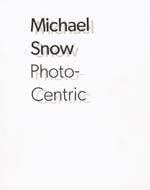
Michael Snow
Photo-Centric
2014
Book softbound
10 x 8 in. (254 x 203 mm)
Published by Philadelphia Museum of Art on the occasion of the exhibition, Michael Snow: Photo-Centric, 2014. Foreward by Timothy Rub. Edited by Adelina Vlas with Essays by Adelina Vlas and Michael Snow.
Price: $30 (ref. 14207)
Photo-Centric
2014
Book softbound
10 x 8 in. (254 x 203 mm)
Published by Philadelphia Museum of Art on the occasion of the exhibition, Michael Snow: Photo-Centric, 2014. Foreward by Timothy Rub. Edited by Adelina Vlas with Essays by Adelina Vlas and Michael Snow.
Price: $30 (ref. 14207)